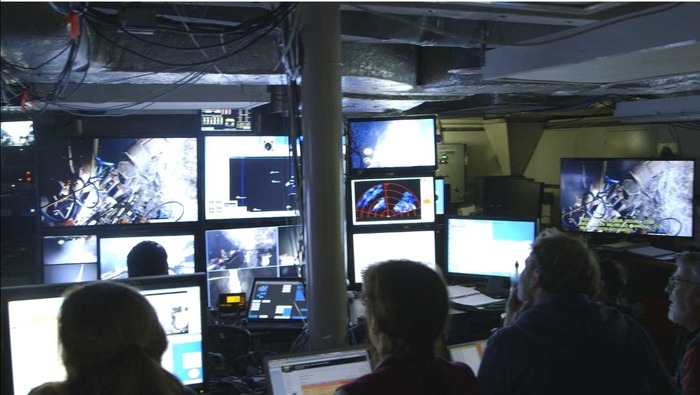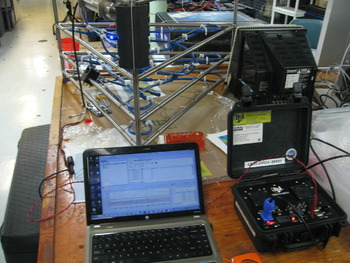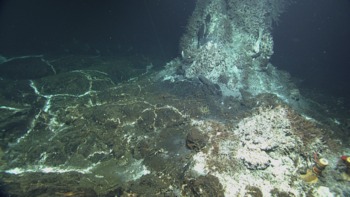31 July 2013
Before the cruise I didn’t have much of an idea about what I would be doing while on the ship. One thing I did know was that all the students would be taking 4 hour watches. I’m not entirely sure I knew what "watch" meant or what we might even be "watching," but our responsibilities in the ROPOS control room were soon revealed. The control room consists of an impressive array of TV monitors and humming equipment. At the exciting or critical moments the room would be packed full with people. Everyone was generally quiet, allowing the pilots to concentrate and easily communicate with each other and with the scientist in the “hot seat.” The “hot seat” person is the science party liaison to the ROPOS crew, giving them instructions and monitoring their progress. This is helpful for the pilots because they only have to listen to one person rather than a room full. Of course, if there is an unexpected or difficult situation, everyone in the room converges to discuss the best way to proceed.
Generally there are three pilots, a navigator, a representative from the science party leading the dive, and two loggers in the control room. One pilot flies the ROV and the other two each control one of the robotic manipulators. One impressive quality of the ROPOS team is that they can all perform any of the tasks and frequently switch roles to give each other breaks during their 12-hour shifts.
The students generally fill the logging positions. Our responsibilities are to log everything that happens underwater. This is done through an integrated logging system that records the time and position of the ROV. One logger comments on what is happening, noting key specifics that may be useful in the future. The other logger’s job is to take pictures with the Digital Still Camera that is on the ROV. This person attempts to capture significant events that might include how a cable is lying on the seafloor, the final position of a deployed instrument, or even a delicate jelly fish. The purpose of all this is to allow for easy future reference. Engineers or scientists can look back at any dive and breeze through the annotations and photos to find what they need and, if necessary, access the recorded video. This is especially important because we have only installed a few instruments on this cruise because the primary backbone system is not yet available for connecting. We will be coming back to install and connect more instruments next year and probably even more in 5 to 10 years. It will be important to see where and how everything was left and what environment the instruments are in.
28 July 2013
After setting up the thermistor array explained in my previous post, I have done some simple tests of its functionality. I set up my computer with the sensor’s proprietary software and hooked up through USB. The medium-power junction-box simulator provided power to avoid draining the batteries. After reading the instrument spec sheets and manual and after consulting with Giora Proskurowski, I had the sensors giving me readings in real time. It was interesting to note that the temperature gradient just sitting in the room where the readings were taken differed by up to 1.25 degrees Celsius. After inverting the assembly we were pleased to see the readings reverse, proving it was not just a calibration error.
My next test was to try logging data. Through the instrument’s software interface I set a schedule for it to record. I then unplugged my computer and came back after its time was up. I dumped the stored data on my computer and transferred it to Excel. The data was there and everything seemed to work fine.
We explored the deployment site yesterday and chose a spot at the base of a hydrothermal vent named Mushroom in the Ashes vent field. The thermistors are embedded in a cable that is only rated up to 50 degrees Celsius, which is alarmingly low when compared to the fluids in the vents that can reach 300 degrees C. So care was taken to choose a safe spot that did not have such harmful and extreme temperatures.
25 July 2013
Today I set up a thermistor array, shown in photo above, for a study Giora Proskurowski is conducting. The purpose of the array is to create a 3-dimensional thermal model of diffuse flow near a hydrothermal vent on the seafloor. The array consists of a string of thermistors embedded in a cable and wrapped around a triangular frame. The thermistors towards the bottom of the sensor are spaced closer together to get a higher resolution sample where most of the temperature gradient will take place. This unit is one of the few instruments in the RSN project that is fully functional when running off battery power. Sometime in the next two weeks the array will be deployed in the Ashes hydrothermal site at the base of a hydrothermal vent and recovered only a couple days later. If the test run goes well this array will eventually be adapted to plug into the RSN network.
22 July 2013
Dive 1608 on July 21st ended before ROPOS even touched water when a kink in the ROPOS umbilical was discovered. Although the cable was still functional, the ROPOS team decided to cut the cable above the kink and reterminate in case the cable's strength or electrical or optical connections were compromised. The total retermination process takes 12 to 14 hours. It has two major components: the electrical/optical connections and the strength member.
To undo the electrical/optical connections Jonathan Lee, a member of the ROPOS team, showed me how they empty the oil-compensated termination box and decouple the connections from their terminals. Later that evening I watched as they terminated the fiber connections. The hair-like fibers are glued into a connector and the end is polished by hand with up to 1 micron sandpaper. I took a peek through the microscope to see the imperfections in the fiber. The imperfections show up as white blotches in the end of the fiber that slowly disappear as the surface is polished.
For the strain relief, the cable’s armor, which is wrapped on the outside, was frayed out and bent back like a barb. This was then stuffed into the mechanical couple at the top of the ROV and epoxied in place. The resulting high-strength couple is stronger than the cable itself.
The process went smoothly over our 18 hour transit from Hydrate Ridge to Axial Seamount and ROPOS was back in the water as soon as we were on site.




